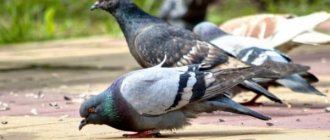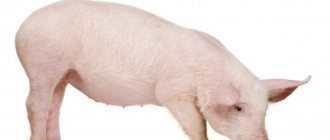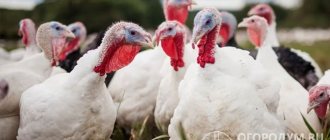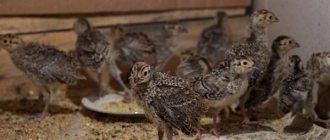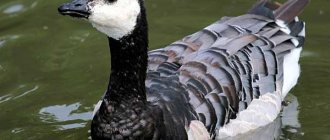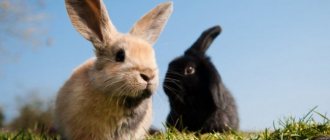It's no secret that the “foundation” for the health of any living creature, including farm animals and poultry, is laid at an early age. Geese, compared to other domestic birds, are distinguished by strong innate immunity, are adapted to digesting various types of food and forgive some mistakes typical of novice poultry farmers. However, it is important to know what to feed goslings correctly in the first days of life, so that later you do not have to deal with problems such as poor weight gain or livestock diseases.
Children from an early age are able to obtain food in meadows and ponds
What to feed goslings in the first days of life
On the first day, goslings are provided with yolk, the main product to which the chicks’ organisms are adapted. It is boiled and ground, diluted with boiled water. It is necessary to feed hatched goslings up to 7-8 times a day. This diet continues for the first 3-4 days, other ingredients are gradually added, accustoming the child to solid food.
After 7-8 days, fresh green food is introduced into the diet. Green onions are best suited. It is crushed into small pieces, no more than 2-3 mm, so that the goslings do not choke while eating. It is practiced to mix yolks with meadow grasses rich in protein: alfalfa, clover. Chicks readily eat low-fat cottage cheese; it is periodically added to the food after 3 days of life.
Advice! It is recommended to include fresh fermented milk products in the diet of little goslings: yogurt, whey.
You can feed day-old goslings with special combined feeds, with balanced proportions of essential microelements and vitamins. Such mixtures are offered for chicks of all ages, from the first days of life.
Feed 5 day old goslings with bread crusts, previously soaked in water, gradually add boiled root vegetables, porridge from fine grains: semolina, millet, wheat, oatmeal.
Advice! Food for feeding goslings is given only freshly prepared food. The food in the feeders should not be allowed to sour.
Day-old goslings hatched in an incubator should be fed immediately after they are completely dry. The survival rate increases from the moment the chicks begin to eat on their own. Basically, their diet does not differ from the standard feeding regime for goslings. Young animals are given only boiled water, adding vitamins and drugs that increase immunity and prevent infections and diseases.
Those who are weak and stunted are given Baytril, an antibacterial agent used for preventive purposes. The medications Furazolidone and Metronizadol are used. 2 tablets, crushed into powder, are diluted in 1 liter of water. For prevention, healthy birds are given a solution in the following proportion: 1 tablet per 1 liter of water.
Compound feed
Compound feed can be given to chicks from one week of age. Industrial products such as Rost, Purina, and Solnyshko are suitable. You can also give other feed, which contains a large amount of proteins. From three weeks of age, PK-6 and PK-31 can be administered. It is acceptable to use other feed with a high calorie content.
Whole grain food for chicks is available for sale. It must first be ground and slightly moistened with water. If you feed whole grain feed without preliminary preparation, the goslings will have digestive problems.
What to feed week-old goslings
When the goslings are a week old, their diet becomes more varied, enriched with vitamins and fiber. A nutritious mixture is prepared from several ingredients:
- grated zucchini and carrots;
- bran;
- greenery;
- crushed grain;
- boiled potatoes;
- meadow grasses;
- boiled porridge and eggs.
Birds must have 24/7 access to clean water. Geese not only drink and bathe, but also rinse their beaks, clearing them of food debris. A clogged nasopharynx can cause the death of young animals.
At home, the birds are kept in dry, warm rooms equipped with feeders and drinkers, with the possibility of walking the young in the fresh air. The amount of the nutrient mixture is gradually increased as the young animals grow up.
10 day old goslings have an active growth phase, so the diet requires peas and legumes, pre-soaked and boiled. The volume of food is increased gradually by 30-35 percent. The consumption of fish oil, bone meal, nutritional yeast, and vitamin supplements is beneficial for growing birds. Vegetables continue to be given in boiled and chopped form.
Advice! When preparing the feed mixture, care should be taken to ensure that the structure remains crumbly.
Goslings at 10 days of age continue to be fed 6-7 times a day. On average, at least 150 g of mixed food is expected per individual.
Rations
Household owners often use ready-made recipes. This is convenient, since there is no need to find out the content of individual elements in each component; everything is recalculated by the weight of the bird, adhering to the percentage. If you still need a detailed study of diets, then I strongly recommend mastering Excel. It is enough to enter the values of all available feeds once and then simply change the weight until the desired result is achieved. Counting by hand takes too long and there is a high risk of making mistakes!
Below are approximate diets for goslings of different ages:
| Component (%) | 1-3 weeks | 4-9 weeks |
| Corn | 32 | — |
| Wheat | 38 | 40 |
| Barley | — | 25 |
| Schrot | 12 | 5,5 |
| Yeast | 3 | 5 |
| Fish flour | 3 | 4 |
| Meat and bone meal | 1 | 2 |
| Bone flour | 0,5 | 1 |
| Herbal meal | 5 | 10 |
| Chalk/shell | 1,5 | 2,5 |
| Salt | 0,2 | 0,5 |
| Fat | 2,8 | 3,5 |
| Premix | 1 | 1 |
The following table is a recipe proposed by Academician S.I. Smetnev for fattening geese for meat when kept without walking until 2 months of age:
| Component (%) | 1-20 days | 21-65 days |
| Corn | 10 | 24 |
| Wheat | 45,8 | 45 |
| Barley | 15 | 6 |
| Schrot | 18 | 15 |
| Fish flour | 5 | 3 |
| Meat and bone meal | 2 | 2 |
| Bone flour | 0,6 | 0,7 |
| Yeast | 2 | 2 |
| Chalk/shell | 0,5 | 1 |
| Salt | 0,1 | 0,3 |
| Premix | 1 | 1 |
An option without the use of animal feed is offered by P. F. Saleev and E. I. Ionova:
| Component (g) | 1-30 days | 31-65 days |
| Corn | 75 | 80 |
| Wheat bran | 16 | 27 |
| Cake | 6 | 4 |
| Peas | 12 | 27 |
| Chalk | 1,7 | 1,6 |
| Salt | 0,4 | 0,5 |
| Potato | 100 | 160 |
| Greenery | Plenty | |
The grain should be crushed, potatoes (or peelings) should be given boiled
It is forbidden to feed the bird green tubers, as well as potato sprouts. The water after cooking is discarded, as it contains corned beef, which can cause poisoning to the goslings.
Many poultry farmers prefer to prepare mash. Any of the proposed diets can be diluted with warm water, whey, fish or meat broth. The main thing is that the mash is not too sticky. The nasal cavity clogged with food often becomes inflamed, which leads to serious illnesses.
What to feed 2 week old goslings
A grown two-week-old bird is fed less frequently, up to 5 times a day. The volume of food is gradually increased. Grinded chopped raw vegetables, cereals, and herbs are added to the mash.
Water can no longer be given without boiling, but it must be clean, not from the tap. It is advisable to use a well, a spring, or from any flowing body of water. The basis of the geese's diet is grass; when the weather warms, they are grazed or provided with freshly cut plants.
Advice! Young birds should not be released onto the grass with dew or after rain.
Professionals recommend placing containers with crushed chalk, sand or shells next to the feeders; this will provide the bird with calcium as an additive to the diet. For prevention purposes, a weak solution of potassium permanganate is used, which is added to drinking water.
Video
Experienced poultry farmers share practical advice on fattening geese for meat in the following videos:
I moved from a stuffy city to a village and dream of staying here forever. Being a very lazy gardener, I try to simplify my work as much as possible, using all the safe achievements of science and technology. Veterinarian by training. I plan to have a lot of different living creatures: from worms to horses.
Found a mistake? Select the text with the mouse and click:
It is believed that some vegetables and fruits (cucumbers, stem celery, all varieties of cabbage, peppers, apples) have “negative calorie content,” that is, more calories are consumed during digestion than they contain. In fact, only 10-20% of the calories received from food are consumed in the digestive process.
“Frost-resistant” varieties of garden strawberries (more often simply “strawberries”) need shelter just as much as ordinary varieties (especially in those regions where there are snowless winters or frosts alternating with thaws). All strawberries have superficial roots. This means that without shelter they freeze to death. Sellers’ assurances that strawberries are “frost-resistant,” “winter-hardy,” “tolerates frosts down to −35 ℃,” etc. are deception. Gardeners must remember that no one has yet managed to change the root system of strawberries.
A new product from American developers is the Tertill robot, which weeds weeds in the garden. The device was invented under the leadership of John Downes (creator of the robot vacuum cleaner) and works autonomously in all weather conditions, moving over uneven surfaces on wheels. At the same time, it cuts off all plants below 3 cm with the built-in trimmer.
The homeland of pepper is America, but the main breeding work on developing sweet varieties was carried out, in particular, by Ferenc Horvath (Hungary) in the 20s. XX century in Europe, mainly in the Balkans. Pepper came to Russia from Bulgaria, which is why it received its usual name - “Bulgarian”.
Convenient Android applications have been developed to help gardeners and gardeners. First of all, these are sowing (lunar, flower, etc.) calendars, thematic magazines, and collections of useful tips. With their help, you can choose a day favorable for planting each type of plant, determine the timing of their ripening and harvest on time.
Natural toxins are found in many plants; Those grown in gardens and vegetable gardens are no exception. Thus, the seeds of apples, apricots, and peaches contain hydrocyanic acid, and the tops and peels of unripe nightshades (potatoes, eggplants, tomatoes) contain solanine. But do not be afraid: their number is too small.
In Australia, scientists have begun experiments in cloning several varieties of grapes grown in cold regions. Climate warming, which is predicted for the next 50 years, will lead to their disappearance. Australian varieties have excellent characteristics for winemaking and are not susceptible to diseases common in Europe and America.
You need to collect medicinal flowers and inflorescences at the very beginning of the flowering period, when the content of nutrients in them is highest. Flowers are supposed to be picked by hand, tearing off the rough stalks. Dry the collected flowers and herbs, scattered in a thin layer, in a cool room at natural temperature without access to direct sunlight.
In little Denmark, any piece of land is a very expensive pleasure. Therefore, local gardeners have adapted to growing fresh vegetables in buckets, large bags, and foam boxes filled with a special earthen mixture. Such agrotechnical methods make it possible to obtain a harvest even at home.
Source
What to feed 3 week old goslings
From the age of three weeks, the young spend most of their time outdoors, feeding on vegetation. Feeding is reduced to 3 times a day. Added to the diet:
- wheat and barley;
- bran;
- grated or ground fresh vegetables (beets, carrots, potatoes, zucchini, pumpkin);
- cake (no more than 1 time in 3 days);
- spurge;
- ground eggshells;
- dandelions;
- grated dry bread.
Goslings should not experience a lack of water; it must be changed constantly, making sure the containers are clean. The litter is also kept dry, changing every day. Gradually transfer 20 day old goslings to solid food.
Reference! At the age of 3 weeks, the goslings are already fully fledged. They love to graze on the grass and swim.
Experienced poultry farmers recommend feeding the bird mash in the morning, and dry cereal mixtures in the evening. Wheat and bone meal are added to food to increase calorie content.
Geese can be given boiled and thoroughly chopped fish, animal blood, and milk. Green matter in feed should make up at least half of the diet. Young animals are not yet familiar with herbaceous plants, so the following can be given to poultry in enclosures:
- sow thistle;
- horsetail;
- wheatgrass;
- knotweed;
- sorrel;
- dandelions;
- yarrow;
- bluegrass;
- beet and carrot tops;
- duckweed;
- young nettle.
Reference! Lilies of the valley, ragweed, and quinoa are considered dangerous for goslings.
At this age, the bird is practically formed and is able to feed at night. Therefore, geese should be provided with food around the clock.
Useful herbs
Adult birds sense healthy grass by smell. Goslings have difficulty distinguishing odors, so the poultry farmer is required to let them walk only in places where healthy grass grows. This includes:
- wheatgrass;
- knotweed;
- horsetail;
- carrot tops;
- alfalfa;
- dandelion;
- clover;
- onion;
- garlic;
- duckweed;
- rye.
You can give goslings the herb spurge, but starting from two weeks of age. You cannot feed chicks with lily of the valley, quinoa, or ragweed - they cause poisoning and can lead to death.
What to feed monthly goslings
At the age of one month, geese begin to be intensively fattened. Poultry quickly gains weight, especially meat breeds. Half of the diet consists of selected grain crops, half of fresh green grass and gardening waste. The use of fish oil and vitamin supplements increases the profitability of fattening. The taste preferences of poultry should be monitored by providing them with appropriate ingredients.
It is worth noting the considerable benefits of sunflower cake. The high-calorie product is easily absorbed by the bird's body. It is not given in its pure form; the birds are indifferent to it; the cake should be mixed into the main feed. Only it must be given in a limited manner to avoid gastrointestinal upset.
Advice! It is recommended to give geese “fasting days” by excluding grain crops from the diet.
If at home geese have access to a pond, they stay there most of the time. They feed on duckweed, midges, insects, and plants: reeds, sedges, cattails, chastukha. Thus, they feed in the morning, before grazing, and in the evening, returning home to roost. This significantly saves feed and increases the profitability of geese breeding. This method does not apply to intensive fattening, when owners try to increase the weight of the bird in the shortest possible time and speed up slaughter. After a month, geese do not require special care.
Feeding from four weeks onwards
The diet of goslings from four weeks of age onwards should contain a large amount of green feed. This is due to the need to reduce the fat content of the feed. This prevents excess obesity of the future goose carcass.
Approximate diet for goslings from three weeks and older:
- grain – 35 g;
- boiled potatoes, carrots, turnips – 100 g;
- bran – 40 g;
- greens and green vegetables – 200 g;
- sunflower cake – 25 g.
The purity and availability of water must be monitored. If the drinker is of an open, cup type, then a daily change of water to clean water is implied. Nipple drinkers do not have the disadvantage of rapid water contamination. Geese drink directly from the nipples without coming into contact with the water tank.
Goslings should have free access to fresh water.
Important! Of all the cakes for feed, it is best to choose sunflower or soybean.
Which food to choose?
The goslings' diet should be rich and balanced. If it was not possible to formulate the correct (product composition of feed), the price of meat after slaughter will be lower than the market price.
If preference is given to dry food, young geese (up to one month) will not be able to fully extract all the beneficial substances from them. This is explained by the fact that their gastrointestinal tract is not yet fully formed. Things are much better with ground food, which has been pre-soaked a little in water. Farmers recommend that novice poultry farmers take note of this fact.
When it comes to organizing the maintenance and nutrition of small goslings, ducklings and chickens, it is necessary to take into account that any significant deviation from a normal balanced diet will not go unnoticed. Thus, based on reviews from poultry farmers, a deficiency or predominance of any of the food ingredients can negatively affect the well-being of the bird and cause low-quality meat. It is necessary to give food in accordance with the developed nutrition plan.
What is the ideal food for goslings? This is certainly a crushed green food mass, which is also included in the feed for goslings. It also contains silage, a variety of root vegetables, and ground dried grass. This is considered one of the most successful combinations in poultry nutrition; all poultry farmers recommend giving it.
What not to do
Goslings are delicate creatures and getting low-quality feed into the feeder will immediately lead to diarrhea and then death.
If you make a list of what you cannot feed, it will be like this:
- salty (excess can lead to poisoning and death);
- sour;
- rotten;
- moldy;
- musty.
For rapid growth, goslings should be fed plenty of good quality food. Don't give your goslings anything you can't try yourself.
Like the author!7
- Even more interesting:
- Making nests for laying hens with your own hands
- How and what to feed laying hens to lay eggs better
- Properly caring for goslings
Discussion: 4 comments
Sashka: 12/17/2018 at 08:47 pm Breeding goslings actually has certain nuances and difficulties, and feeding them correctly is a very important aspect that is worth paying attention to. It’s just that at the beginning of my business, as soon as I started breeding them, I fed them incorrectly, and in the end the result was this: poor growth, reproduction is also not very good
Now everything is fine. Answer
Kostya: 12/24/2018 at 10:07 pm I just started breeding goslings, I had certain problems with feeding, I didn’t know how to properly organize their nutrition. Thank you very much for the correct nutritional standards and in general for the advice on how to do all this for a good result. Of course, everything was adjusted and organized correctly. Answer
Sashka: 01/30/2019 at 08:13 pm Geese are really fastidious and you need to know how to feed them properly. Otherwise their breeding will be in jeopardy. Answer
Stella: 02/01/2019 at 20:14 Geese themselves are demanding. If these features are not taken into account, then it will be difficult for them to grow healthy. Reply
Preparing the premises
We must prepare in advance for the appearance of new representatives of the goose tribe.
It is necessary to pay close attention to arranging the space for children. Install feeders and drinkers, lay bedding
Cleaning the interior
To keep the goose barn clean, dry and warm, you need the following:
- The territory intended for education and rearing is carefully scraped from droppings, remnants of old bedding, dirt, and debris.
- Rinse all vertical and horizontal parts of the structure and completely disinfect it using a caustic solution (2%), or any other product with similar properties available.
- To keep the interior dry, you should cover the entire floor surface with fluff lime in advance. Every 1 m2 of area needs to be treated with 0.6-1 kg. substances.
- To keep the room clean and insulate the floor, bedding is placed on it. It can be any material intended for this purpose (straw, hay, sawdust, etc.). You just need it to be dry and not moldy.
Goslings are waterfowl and very often they climb into the drinking bowl (if it is large enough) and bathe in it, splashing liquid. Therefore, their bedding always gets more wet than that of small representatives of other birds (turkey poults, chickens) living nearby.
Remember! To raise 1 gosling up to two months of age, you need to have 7.5-8 kg of bedding in stock.
Drinking bowls
To protect the floor and bedding from getting wet, drinking devices are placed on large baking trays covered with a mesh made of wood or metal. In order not to spend money on industrial drinking bowls, they can be made from scrap materials.
Poultry drinking devices come in a variety of designs. Babies aged 1-15 days. To quench your thirst, many experts suggest installing automatic drinkers made from ordinary cans or plastic bottles. They are similar in operating principle, but have differences in design.
First option
Water bowl for goslings from a jar
It is made of an ordinary glass jar and saucer or shallow basin. This is the simplest version of the drinker, which is called vacuum.
You can do it like this:
- Place 2-3 stands made of wood or plastic in a regular saucer or basin. Their height should be below the edge of the container.
- The jar is filled with water, sharply overturned and placed on stands.
The liquid coming from the jar will never overflow; its level will be lower. This occurs due to the difference between the atmospheric pressure outside and the vacuum that forms inside the container as the water in the jar decreases as it is consumed.
Design of a drinking bowl for goslings
Using this design will prevent little ones from splashing liquid on the floor and getting wet themselves. This reduces the percentage of colds, and the litter remains dry longer.
Second option
Bottle drinking bowl for goslings
According to the operating principle, it is no different from the first one. Instead of a jar, it uses a plastic bottle with a 5-7 cm hole in the bottom.
The fundamental difference from the first option is that it is easier to fill the main container. To do this, simply insert a valve or nipple into the lid and add water when needed without removing the container from the basin.
Drinking bowl for adults
For chicks that have been in the goose house for more than 10-15 days, they are given the option shown in the figure. The water in it is changed every day. This drinker can be made from any material that retains liquid (cement, concrete, plastic, etc.).
Feeder for goslings
The box is calculated as follows. There should be 3-4 cm around the perimeter per baby.
Feeders
From the very beginning of life, babies are taught to eat from low (1.5-2 cm) trays. From day 2, those chicks that trample food are transferred to feeding from prepared troughs.
Dimensions of feeder for goslings
When the babies mature and reach the age of a month, they are given feeders from which the adult geese eat.
Calculate at least 15 cm around the perimeter per individual. The number of devices for eating is selected so that all the goslings can eat at the same time.
Diseases of two-week-old geese
Diseases related to geese can be divided into several categories.
- Non-communicable diseases, such as vitamin deficiency, rickets, diarrhea and the like. To treat such diseases, it is necessary to look for the cause in the daily routine and diet and maintenance. They can appear in one individual or in several, but you should not expect an epidemic, since they are not contagious.
- Diseases of the genital organs, this is vitelline peritonitis, is treated with careful care of the reproductive system and careful care.
- Infectious diseases such as: aspergillosis, salmonellosis, cholera and others. Such diseases are either difficult to cure or cannot be cured, and you need to be prepared for the fact that you will have to kill all the infected birds and thoroughly disinfect the room in which the geese lived.
- Diseases caused by parasites. Whether they are skin parasites or those living inside the body, it is necessary to get rid of them and it is advisable to carry out preventive actions.
- Diseases caused by toxic substances (poisoning). To prevent poisoning, you need to ensure that there is no mold in the feed, there are no prohibited plants in the pasture, and monitor chemicals that can also cause poisoning.
Healthy goslings are a farmer's joy and the prospect of a good income. They are not particularly whimsical in their care, and watching how a yellow lump hatches from the eggs, which then grows into a healthy, strong goose, is a real reward for any livestock breeder.
Features of bird care
To ensure that chicks raised in an incubator do not get sick and can feel as comfortable as possible, you should adhere to the following rules for caring for them:
- In the first days, the room temperature should be 28-29˚C. If the chicks eat and drink well and do not tend to huddle near the heat source, then the heating is organized correctly.
- After 3 days, the temperature begins to gradually decrease, bringing it to 18-20˚C by the age of three weeks.
Goslings under an infrared lamp in a brooder
- For heating, infrared lamps are most often used, which are mounted at an angle.
- Warmth is necessary for goslings, but do not forget that heaters dry out the air, so you should maintain normal humidity in the house by spraying the floor. The humidity level in the first two weeks should be at least 70%, and then about 60%.
The hatchability of chicks hatched by a hen is higher than when raising goslings in an incubator. But in the process of hatching eggs by a goose, a situation may arise when the bird refuses to leave the nest to eat. In this case, it is necessary to force feed the bird to avoid its exhaustion and death. In the first days, it is advisable to provide sufficient heating in the house, since thermoregulation has not yet been established in newborn chicks. During the daytime, the chicks can be with the hen, but at night it is advisable to place them in a separate room.
Prices for egg incubators
Egg incubators
A mother goose may refuse to leave the nest to eat.
Proper care and proper feeding from the first day are the key to the health and absence of disease in the livestock.
Disinfection and cleaning of the poultry house
Conditions for keeping broiler chickens
Proper care and a properly formulated diet are the two main points that poultry farmers should focus on when breeding broiler chickens. If it is not planned to leave some of the young animals for further breeding of the breed, then it is not profitable to raise them for more than 2-2.5 months. After all, after they turn 2.5 months, body weight gain decreases, and broilers continue to absorb feed at the same level. Therefore, their further maintenance becomes unprofitable.
In order for chickens to grow healthy and strong, quickly gain weight and not lag behind in development, they should be kept in proper conditions, provided with proper care and feeding.
The main thing in ensuring normal living conditions is the poultry house, which maintains optimal conditions for the comfortable stay of the chickens, and it is also necessary to maintain sanitation in the room. Proper maintenance, care and proper diet must be established from the first day of the young animals’ stay, since failure to comply with these conditions will lead to mass mortality of chicks.
When raising broiler chickens in a poultry house, it is necessary that this room is warm and dry, and the birds are protected from drafts. The floor should not be cold and damp. Dried sawdust is commonly used as thick bedding, but other materials can be used as bedding. The main requirements for them: they must be constantly dry, loose and clean.
Temperature
Maintaining a constant temperature in the room where broiler chickens grow is one of the main conditions for keeping them. If it is cold in the chicken coop, the chicks will flock together and squeak, in which case the food they absorb will be used to warm them. If the house is too hot, the chicks will suffer from overheating, drink more water, and will practically not touch the food.
The optimal temperature in the room where broiler chicks are kept should be about 25⸰C.
In chickens in the first month of life, thermoregulation is imperfect, so the temperature in the room where they are kept should be slightly increased:
- for chickens in the first 5 days of life – about 25⸰С;
- from 6 to 12 days - 23⸰С;
- at the age of 2 weeks - 22⸰С;
- up to three weeks – 21.5⸰С;
- up to 4 weeks – 20.5⸰С;
- in the future, the room temperature can be from 12 to 19⸰С.
Before one month of age, in winter, in the room where the chicks are located, it is imperative to install heating devices, the temperature near which should be 5-7⸰C higher than in the room.
Broiler chicks are usually raised in cages if there is not enough space on the farm. In this case, the cages are even installed in several tiers, and the temperature and humidity in the room are maintained in the same conditions as when chicks are placed on the floor.
Humidity
In the poultry house where broiler chicks are kept, there must be good ventilation, and the air should not be too dry or humid. The optimal humidity in such a poultry house should be about 60-65%.
Menu of day-old chicks
What to feed goslings in the first days of life, what nutrition is typical for a one-day-old bird? Already from the first day, greens should be present in the diet of day-old winged birds. It should not be less than half of the total diet; this is the golden rule that every poultry farmer tries to adhere to.
It is important to prepare fresh mash each time, while devoting sufficient time to the process of grinding the feed. It is believed that a newborn gosling should eat greens (grass), which have been crushed to particles of about 1-1.5 cm in diameter
If this is not done, there is a chance that the bird will not want to eat such gosling food.
It also happens that already at one day of age there are chicks that are distinguished by their low weight and are significantly lagging behind in development. How to approach the issue of feeding such a bird? Poultry farmers recommend temporarily transferring such goslings to a special dietary treatment. In order to prepare it, you will need:
- milk;
- chicken egg (yolk);
- sugar;
- a general antibiotic (more often than others, biomycin or the well-known penicillin is used).
All ingredients must be warmed to room temperature and mixed thoroughly. In this case, the antibiotic is added not in accordance with the instructions, but in a smaller quantity: at the tip of a teaspoon. The goslings need to be fed and watered with this mixture until they catch up with their peers and get rid of the disease.
